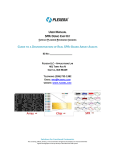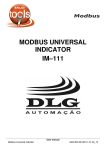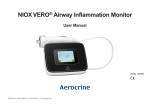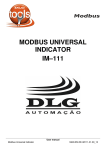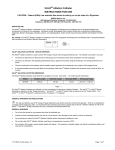Download Labeling Summary / Package Insert NIOX MINO®
Transcript
Labeling Summary / Package Insert NIOX MINO® (According to 21CFR 809.10(b) Labeling for In Vitro Diagnostic Devices) For USA 1 Proprietary and Established Names NIOX MINO® Airway Inflammation Monitor measures the concentration of fractional exhaled nitric oxide (FENO) in human exhaled breath. 2 Intended Use NIOX MINO® measures Nitric Oxide (NO) in human breath. Nitric Oxide is frequently increased in some inflammatory processes such as asthma. The fractional NO concentration in expired breath (FENO), can be measured by NIOX MINO according to guidelines for NO measurement established by the American Thoracic Society. Measurement of FENO by NIOX MINO is a quantitative, non-invasive, simple and safe method to measure the decrease in FENO concentration in asthma patients that often occurs after treatment with anti-inflammatory pharmacological therapy, as an indication of the therapeutic effect in patients with elevated FENO levels. NIOX MINO is suitable for children, approximately 7 - 17 years, and adults 18 years and older. FENO measurements provide the physician with means of evaluating an asthma patient’s response to antiinflammatory therapy, as an adjunct to the established clinical and laboratory assessments in asthma. NIOX MINO should only be used as directed in the NIOX MINO User Manual and the NIOX MINO Quality Control Test User Manual, by trained physicians, nurses, respiratory therapists and laboratory technicians. NIOX MINO cannot be used with infants or by children approximately under the age of 7, as measurement requires patient cooperation. NIOX MINO should not be used in critical care, emergency care or in anesthesiology. Labeling Summary NIOX MINO EPS-000063-04/ Aerocrine AB page1 of 32 3 Summary and Explanation 3.1 Methodology background Nitric Oxide is endogenously produced in the airways[1] and production is increased when there is airway inflammation[2]. Exhaled NO is elevated in asthma and correlates with generally accepted clinical markers of airway inflammation, such as sputum eosinophils[3-8], eosinophils in bronchoalveolar lavage[9, 10] and in bronchial biopsies[11, 12]. Levels of exhaled NO in patients with asthma correlate with disease activity such as frequency of beta-2 agonists use, and day and night time asthma symptoms, as measured in clinic visits and/or patient diaries[13-15]. Treatment of airway inflammation in asthma with anti-inflammatory agents such as inhaled and/or oral corticosteroids and/or anti leukotrienes reduces levels of NO in exhaled air[16-28]. Exhaled NO measurements can be used for monitoring the effect of anti-inflammatory therapy such as inhaled and/or oral corticosteroids and/or anti leukotrienes, but not to monitor the effect of bronchodilators, since these primarily relieve the bronchoconstriction and have limited effect on the inflammation. Published guidelines allow standardization of the measurement of exhaled NO[26] , Fractional Exhaled Nitric Oxide, FENO. Measurement of FENO is an easy, non-invasive procedure that can be performed in adults and children[16, 29]. For the above statements, NIOX® was used in study 6, 16, 18, 19, 24, 28 and 29, NIOX MINO® was used in study 27. The other referred studies were performed with other NO analyzers. 3.2 Product characteristics NIOX MINO® is designed as a hand-held device for measuring FENO, a marker of airway inflammation, in exhaled breath from humans. NIOX MINO can be used in children 7- 17 years and in adults. NIOX MINO follows in all essential aspects the American Thoracic Society (ATS) 2005 equipment recommendations for measurement of exhaled NO[26]. NIOX MINO uses an electrochemical sensor technology as analytical method[30]. One vital advantage of this technology is that NIOX MINO requires no calibration. Built-in controls and an External Quality Control Procedure ensure reliability to measured values. 4 Training requirements NIOX MINO should only be used as directed in the NIOX MINO User Manual, by trained physicians, nurses, respiratory therapists and laboratory technicians. “Trained” status is achieved only after careful reading of the NIOX MINO User Manual. 5 Clinical Limitations NIOX MINO is a Prescription Use Device according to 21 CFR 801(D). NIOX MINO cannot be used with infants or by children approximately under age of 7, as it requires patient cooperation. The determining factor for age limitation is based on a patient’s ability to understand and execute the instructions given. Diseases associated with elevated levels of FENO are, aside from asthma, airway viral infections[31], allergic rhinitis[32], systemic lupus erythematosus[33] and liver cirrhosis[34]. Another factor that may increase FENO levels is recent intake of nitrate rich diet[35]. Labeling Summary NIOX MINO EPS-000063-04/ Aerocrine AB page2 of 32 Diseases associated with decreased levels of FENO are, cystic fibrosis[36], primary ciliary dyskinesia[36], and pulmonary hypertension[37]. Smoking reduce exhaled NO values, however elevated FENO levels in smokers still indicate ongoing eosinophilic inflammation[38, 39]. Other factors that may decrease FENO levels transiently are: physical exercise[40], spirometric maneuvers[41] and bronchoconstriction[40, 42]. Other factors that may affect the level of exhaled NO upwards or downwards are more extensively reviewed in section 12 Limitations of the procedure. The fact that no change in FENO is encountered for some patients despite anti-inflammatory treatment could be due to non-compliance, poor inhaler technique or inadequate corticosteroid dosage. There may also be a small number of patients, especially those with severe asthma, who are unresponsive to steroid treatment[43, 44]. In the multi-center device randomized open label prospective study performed with NIOX MINO® described in section 14, 26 out of 147 of the subjects (18%) did not show a significant decrease in FENO value despite a significant change in Asthma Control Questionnaire (ACQ)[45] . For NIOX® the figure was 28 out of 147 subjects (19%). In a previous study performed with NIOX, 11 out of 62 patients (18%) showed no decrease in FENO after antiinflammatory treatment, and 9 out of 62 (15%) showed no decrease in FENO despite improvement in asthma symptoms[16]. The medical explanation behind a lack of FENO change has not been explicitly evaluated. 6 Risks to Health There are no known direct risks to patient health. However, failure of the test to perform as indicated or erroneous interpretation of results may lead to improper patient management. Therefore, use of FENO measurement results to adjust a treatment regimen without consideration of other clinical factors could pose a risk. 7 Test Principle 7.1 System description and functions List of materials provided: NIOX MINO® instrument including Power Supply Unit NIOX MINO User Manual, (incorporating a NIOX MINO QC Manual) NIOX MINO Scrubber NIOX MINO QC plug USB stick with Visual Incentive Test kits, including: NIOX MINO® Sensor (for 50, 100, 300 500 or 1000 tests) NIOX® Filter - disposable patient filters (box of 50, 100,3x100, 5 x 100, or 10 x 100 filters) Accessories: NIOX MINO Data Management Program (Optional PC application) NIOX MINO scrubber, spare part for regular exchange. Labeling Summary NIOX MINO EPS-000063-04/ Aerocrine AB page3 of 32 Figure 1 NIOX MINO instrument NIOX MINO is a hand held instrument for exhaled NO analysis, applying the FENO method. The instrument is intended for use together with a Power Supply Unit, NIOX® Filter, NIOX MINO® Sensor, and optional NIOX MINO Data Management (PC application) Figure 2, NIOX Filter NIOX® filter is a single use bacterial and viral filter which is attached to the sample inlet to prevent contamination of the instrument and between patients. Figure 3, NIOX MINO Sensor Labeling Summary NIOX MINO EPS-000063-04/ Aerocrine AB page4 of 32 NIOX MINO® Sensor is an electrochemical sensor pre-calibrated and pre-programmed for a defined number of tests (50, 100, 300 500, or 1000 tests).The user may easily change it after the measurements have been used up. The instrument will also alert the user to sensor expiration two weeks prior to the expiration date and will not allow for measurements with an expired sensor. Figure 4, NIOX MINO Scrubber NIOX MINO Scrubber is an exchangeable NO scrubber, for elimination of ambient NO in the patient sample. 7.2 Operating principles The patient should empty the lungs and then inhale through the NIOX Filter (mouthpiece) NO-free air to total lung capacity (TLC) in order to trigger the measurement procedure. The pressure parameters are controlled by both visible and audible feedback in order to guide the patient in performing a valid exhalation maneuver. A continuous sound is heard and a steady top light is shown as long as the pressure is maintained. A standard exhalation sampling is performed during 10 seconds. As the exhaled NO levels are flow dependent, NIOX MINO cues mean exhalation rate for a valid measurement to be within be 50 5 mL/sec (BTPS), in accordance with the ATS guidelines[26]. With exhalation pressure within the specified limits (10-20 cm H2O) the built-in NIOX MINO® dynamic flow controller ensures a flow rate of 50 mL/sec. Figure 5, graphical interaction image for correct exhalation If the pressure from the patient is lower than 12 cm H2O a low intermittent sound is heard and a flickering top light is shown. If the pressure exceeds 18 cm H2O a high intermittent sound is heard and a flickering top light is shown. On the display a pressure controlled graphical interaction image is shown. Labeling Summary NIOX MINO EPS-000063-04/ Aerocrine AB page5 of 32 Figure 6, graphical interaction image for too hard exhalation and too low exhalation The patient can see the display during his/her exhalation by using a mirror. The patient is thereby guided to maintain the pressure within the specified limits. Exhalation pressures outside the specified 10-20 cm H2O limitation render an Alert message is shown on the display. A three-second adaptation time period outside the specified pressure range is allowed in the beginning of the exhalation. The results are processed using dedicated software, expressed as the NO concentration in parts per billion (ppb), and are presented on the display 1 minute 40 seconds after the exhalation. 7.3 Operating and maintenance instructions For details regarding the operational and maintenance procedures, please refer to NIOX MINO® User Manual. 7.4 Quality Control procedures NIOX MINO® provides built-in internal controls as well as an External Quality Control procedure for the user to verify the reliability of measurements. The External Quality control procedure should be performed daily and is prompted for by the instrument. An asterisk is displayed by every presented measurement result if the external Quality Control procedure has not been successfully performed. The Quality Control Procedure consists of a sequential positive and negative control. 1. The positive control is performed using exhaled breath samples from one or more qualified staff members. The qualified staff member should have an expected FENO value, within the range 5 – 40 ppb. The staff member performs a standard exhalation test, and the instrument should display a result that is close to the persons normal measurement result (± 10 ppb). The measurement result is calculated as the mean value from three measurements performed on three sequential days. This reference value is updated on a regular basis. 2. The negative control consists of a NO free sample of ambient air scrubbed through the exchangeable NOscrubber. The result is compared with sample generated from the zero-scrubber, used for baseline control. The result should be < 5 ppb. Please refer to the Quality Control section in NIOX MINO® User Manual for further details on the Quality Control procedure. Labeling Summary NIOX MINO EPS-000063-04/ Aerocrine AB page6 of 32 8 Hazards The following warnings apply in the handling and operation of NIOX MINO®: Warning Handle the NIOX MINO instrument as stated in the User Manual. Aerocrine accepts no responsibility for damaged equipment or faulty results, if the equipment is not used according to the User Manual. Warning: Do not use a damaged NIOX MINO instrument or damaged components. Warning: Use only the Power Supply unit provided. Warning: Keep the instrument out of water. Ensure that no liquid is spilled or dripped on the instrument. Warning: Do not heat or dispose the instrument or sensor in fire. Please refer to the “Disposal of used/expired products” section of the User Manual. Warning: Take care not to drop the instrument or subject it to strong impact. Warning: It is recommended not to use NIOX MINO in the proximity of areas where volatile substances such as organic fluids or disinfectants are being used. Special attention should be paid to aerosols and disinfection baths (either open vessels or ultrasonic baths). Warning: NIOX MINO should not be used adjacent to or stacked with other equipment. Warning: The NIOX MINO Sensor contains chemicals that could be harmful if swallowed. Warning: Touch only the grey cap when exchanging the sensor. Warning: Do not clean the sensor. Cleaning of the Sensor with ethanol or similar disinfectant might destabilize it for a nonpredicable time period. Warning: Keep the sensor out of water. Ensure that no liquid is spilled or dripped on the sensor. Warning: The NO scrubber contains potassium permanganate and should be disposed of as hazardous waste in accordance with the local waste disposal regulations. Labeling Summary NIOX MINO EPS-000063-04/ Aerocrine AB page7 of 32 Warning: When selecting an accessory for your NIOX MINO please keep in mind that an accessory not recommended by Aerocrine may result in loss of performance, damage to your NIOX MINO, fire, electric shock, injury or damage to other property. The product warranty does not cover product failure or damage resulting from use with nonapproved accessories. Aerocrine takes no responsibility for health and safety problems or other problems caused by the use of accessories not approved by Aerocrine. Warning: No modification of the NIOX MINO instrument or the Sensor is allowed. The following cautions apply in the handling and operation of NIOX MINO: Caution: Measurement results are to be used as an adjunct to established clinical and laboratory assessments in asthma. Caution: Mobile phones and cordless phones might interfere with the instrument and should therefore be kept away from the instrument. Interference could make it impossible to perform a measurement. Caution: Make sure that you use the required measurement mode, otherwise incorrect exhaled NO results might be obtained. Caution: Use of substances containing alcohol close to NIOX MINO may cause erroneous measurement results. Caution: Do not reuse the NIOX Filters. Caution: The NIOX MINO instrument might produce some heat during normal operation, the temperature could increase up to 10 ºF above the ambient temperature. Make sure that the base ventilation slots are not blocked. Do not place the instrument on a bed, sofa, carpet or other soft surface. Caution: A maximum of 10 measurements/hour can be performed during continuous use. However, it will be possible to perform 20 measurements per hour if the instrument is allowed to rest for a minimum of 30 minutes after that. Caution: The NIOX MINO® Sensor shall be kept in its original unopened package before installation. Caution: The NIOX MINO Sensor shall be kept in its original unopened package before installation. For transportation and storage conditions, refer to the corresponding section in this manual. Caution: Keep the NIOX MINO sensor out of reach of children. Caution: The NIOX MINO Sensor is sensitive to changes in ambient temperature and humidity. Labeling Summary NIOX MINO EPS-000063-04/ Aerocrine AB page8 of 32 Caution: Do not touch or clean the white sensor membrane. Caution: Be careful when opening the sensor can. The inside of the opening has sharp edges. Caution: Best performance is achieved if the ambient conditions are stable. Refer to the “Operating conditions” section in the NIOX MINO User Manual. Keep the instrument away from windows, sunshine, radiators, stoves or open fire in order to avoid unstable conditions. When transporting the instrument from one location to another, a prolonged stabilization period before measurement might be required. Refer to the recommended transportation conditions in the “transport and storage” section in the NIOX MINO User Manual. Always use the NIOX MINO Bag for transportation. Keep the NIOX MINO with mounted sensor connected to the power outlet whenever possible. Caution: Elevated ambient Nitrogen Dioxide (NO2) may interfere with FENO measurement; therefore, ensure that the patient inhales correctly according to instruction solely through the NIOX filter. Caution: NIOX MINO has been tested and found to comply with the limits for medical devices according EN/IEC 60601-1 Safety requirements for medical electrical systems and electromagnetic compatibility. These limits are designed to provide protection against harmful interference in a typical medical installation. However, because of the increased use of radio-frequency transmitting equipment and other sources of electrical noise emitters in the health-care and home environments, such as base stations for radio, cellular/cordless telephones and land mobile radios, amateur radio, AM and FM radio broadcast and TV broadcast, it is possible that high levels of such interferences due to close proximity or strength of a source, may result in disruption of performance of the device. If abnormal performance is observed, it may be necessary to reorient or relocate NIOX MINO. Caution: A PC connected to the USB connector has to be certified for one of the standards IEC 60601-1, IEC 61010-1, IEC 60950 or comparable with safety extra low voltage on the USB ports. Caution: The connected PC should be placed out of reach from the patient. Do not, simultaneously, touch the connected PC and the patient. Labeling Summary NIOX MINO EPS-000063-04/ Aerocrine AB page9 of 32 9 Specimen collection and preparation for analysis NIOX MINO® provides direct sampling with delayed analysis (100 seconds) of sequentially collected and analyzed exhaled air. No subsequent specific specimen collection, specimen preparation or reagents are required. 10 Step by step outline of recommended procedures For details regarding the operation of NIOX MINO read the ‘NIOX MINO® User Manual’. 11 Results The FENO results, expressed as parts per billion (ppb), are presented after a short time (about 100 seconds) on the display. The instrument calculates the result based on the calibration settings (sensitivity) of the Sensor, expressed as nA/ppb. For details regarding the FENO measurement and results, please read the ‘NIOX MINO® User Manual’. Caution: FENO measurement results are to be interpreted in conjunction to other clinical and laboratory assessments of the patient’s condition. Labeling Summary NIOX MINO EPS-000063-04/ Aerocrine AB page10 of 32 12 Limitations to the procedure Known patient factors that could interfere with FENO measurement are described in the ATS guidelines[26]. To assure correct results when performing FENO measurement with NIOX MINO®, the following cautions apply: Caution: Respiratory maneuvers Because spirometric maneuvers have been shown to transiently reduce exhaled NO levels, it is recommended that NO measurement be performed before spirometry. The same stipulation applies to other taxing respiratory maneuvers, unless these can be shown not to influence exhaled NO. The FENO maneuver itself and body pletysmography do not appear to affect plateau exhaled NO levels[26]. Caution: Age/sex In adults, there is no consistent relationship between exhaled NO level and age, but it has been reported that, in children, FENO increases with age. In adults, there are conflicting reports regarding the effects of sex, menstrual cycle and pregnancy, so these patient characteristics should be recorded at the time of measurement[26]. Caution: Airway caliber It has been demonstrated that FENO levels may vary with the degree of airway obstruction or after bronchodilatation, perhaps because of a mechanical effect on NO output. Depending on the setting, it may be prudent to record the time of last bronchodilator administration and some measure of airway caliber, such as FEV1[26]. Caution: Food and beverages Patients should refrain from eating and drinking before NO analysis. An increase in FENO has been found after the ingestion of nitrate or nitrate-containing foods, such as lettuce (with a maximum effect 2 hours after ingestion) and drinking of water and ingestion of caffeine may lead to transiently altered FENO levels. It is possible that a mouthwash may reduce the effect of nitrate-containing foods. Until more is known, it is prudent when possible to refrain from eating and drinking for 1 hour before exhaled NO measurement, and to question patients about recent food intake. Alcohol ingestion reduces FENO in patients with asthma and healthy subjects FENO[26]. Caution: Circadian rhythm Although FENO levels are higher in nocturnal asthma, there was no circadian rhythm in two studies, but another study did report a circadian pattern, so it is uncertain whether measurements need to be standardized for time of day. It is, however, prudent, where possible, to perform serial NO measurements in the same period of the day and to always record the time[26]. Caution: Smoking Chronically reduced levels of FENO have been demonstrated in cigarette smokers in addition to acute effects immediately after cigarette smoking. Despite the depressant effect of smoking, smokers with asthma still have a raised FENO. Subjects should not smoke in the hour before measurements, and short- and long-term active and passive smoking history should be recorded[26]. Labeling Summary NIOX MINO EPS-000063-04/ Aerocrine AB page11 of 32 Caution: Infection Upper and lower respiratory tract viral infections may lead to increased levels of exhaled NO in asthma. Therefore FENO measurements should be deferred until recovery if possible or the infection should be recorded in the chart. HIV infection is associated with reduction in exhaled NO[26]. Caution: Medications and exhaled NO. The potential effect of drugs on NO cannot be excluded, and so all current medication and time administered should be recorded. Exhaled NO falls after treatment with inhaled or oral corticosteroids in subjects with asthma and after inhaled NO synthase inhibitors. Leukotriene-axis modifiers also reduce FENO. NO donor drugs and oral, inhaled, and intravenous L-arginine increase FENO and nasal FENO. Even if a certain medication does not affect NO production, it might affect the apparent level of NO through other mechanisms, such as changes in airway caliber[26]. Caution: Other factors The manipulation of physiologic parameters has been shown to affect FENO. Changing pulmonary blood flow has no effect in humans, but hypoxia decreases exhaled NO, and this may occur in subjects at high altitude, particularly those prone to high-altitude pulmonary oedema. The application of positive end-expiratory pressure has been shown to increase FENO in animals, but airway pressure in humans does not affect exhaled NO plateau levels according to most reports, although one study suggests the opposite. Many studies have examined the effect of exercise on FENO. During exercise, according to one report, FENO falls, whereas NO output increases, and this effect may last up to 1 hour. Others have reported that FENO remains stable after exercise. It would seem prudent to avoid strenuous exercise for 1 hour before the measurement[26]. Caution: Ethnic differences in ‘healthy’ FENO levels have been observed. In schoolchildren Asian (boys) could have 6- 15 ppb higher FENO levels than Caucasians boys . By contrast, Asian girls have elevated FENO levels to a lesser extent. African- Americans children seem to have slightly higher ‘healthy’ FENO levels than Caucasians; 17 ppb versus 12 ppb. In African-American adults slightly higher average ‘healthy’ FENO levels than Caucasians, 20 ppb versus 17-18 ppb have been observed. 13 Expected Values Given that physiological and environmental factors can affect FENO levels, in clinical practice, ‘healthy’ FENO levels need to be established on an individual basis. However, most healthy individuals will have NO levels in the range 5-35 ppb (children slightly lower 5-25 ppb) when measured at 50 mL/s[46-53]. Analysis of the variation seen in such studies, suggests that 97% of healthy individuals have FENO levels of less than 35 ppb (< 25 ppb in children). The lower values reported in children indicate an age dependence of FENO levels. It has been shown that FENO levels increase with age in children [50, 51]. Studies have shown that males have higher FENO levels than females [29, 47, 48, 52]. FENO values increase with age[4649] . Ethnic differences in ‘healthy’ FENO levels have been observed. Asian schoolchildren, especially boys, could have up to 15 ppb higher FENO levels than Caucasians[53-55], while Asian girls, had on average elevated FENO levels to a lesser extent. African-American children and adults seems to have a couple of ppb higher average ‘healthy’ FENO levels than Caucasians [46, 53, 54, 56]. It is established that asthma is associated with higher than normal levels of FENO[2, 5, 29, 43, 57, 58]. However, FENO levels in asthma patients vary greatly depending upon the extent of their airway inflammation. Literature data suggest that patients with asthma usually have FENO levels in the range 25–80 ppb[5, 18, 19, 24, 29, 59] although higher levels may occur in some patients. Values at the lower end of the range are usually seen in patients receiving anti- Labeling Summary NIOX MINO EPS-000063-04/ Aerocrine AB page12 of 32 inflammatory treatment [16, 18, 20, 24, 28, 60]. Allergen exposure has been shown to influence FENO levels in asthmatics[60]. Correlation between symptom improvement and decreasing FENO has been observed[16, 18, 24]. Monitoring a patient’s FENO levels before and during anti-inflammatory therapy can, therefore, be used for studying the therapeutic effect[16-20, 24]. However, approximately 18% of subjects in clinical studies with NIOX MINO experienced an improvement in asthma symptoms without a decrease in FENO. Note: If FENO levels are high despite medication, this may indicate non-compliance[14], poor inhaler technique or inadequate corticosteroid dosage [20]. Continuous high levels of allergen exposure create an overwhelming inflammatory activity. There may also be a small number of patients, especially those with severe asthma, who are unresponsive to steroid treatment [43, 44]. Any change of anti-inflammatory therapy can affect FENO levels and should be recorded. Note: Changes in airway inflammation measured as FENO levels and lung function parameters may be non-synchronous as they have different response times to anti-inflammatory treatment [16, 60]. 14 Clinical Data 14.1 Clinical validation, a method comparison study 14.1.1 Study description The study was a multi-center device randomized open-label prospective single-cohort study aimed at demonstrating substantial equivalence between NIOX MINO® and NIOX® when measuring the change of FENO that often occurs after 2 weeks of corticosteroid therapy compared to their baseline levels. Symptomatic asthmatic males and females, from 7 years of age performed two valid FENO measurements at each visit, with NIOX MINO and predicate device (NIOX) respectively, with a limit of six exhalation attempts per subject and per device. The order of the FENO measurement on NIOX MINO versus NIOX was randomized. At every visit and for every patient, spirometry was performed and asthma symptoms were recorded using Asthma Control Questionnaire® (ACQ). In total, 156 subjects were included, 105 adults 18 - 70 years old and 51 children 7 - 17 years old were recruited. 147 individuals performed valid measurements on both visits and were evaluable per protocol. Labeling Summary NIOX MINO EPS-000063-04/ Aerocrine AB page13 of 32 Table 1: Demographics in method comparison study. Gender Adults (N=105) Children (N=51) Total (N=156) n (%) Male 53 (50.5) 31 (60.8) 84 (53.8) 52 (49.5) 20 (39.2) 72 (46.2) Caucasian 100 (95.2) 42 (82.4) 142 (91.0) African 2 (1.9) 2 (3.9) 4 (2.6) Hispanic - 1 (2.0) 1 (0.6) Asian 2 (1.9) 4 (7.8) 6 (3.8) Other 1 (1.0) 2 (3.9) 3 (1.9) Mean (SD) 42.9 (14.9) 12.3 (2.9) 32.9 (19.0) Median 42.0 13.0 30.0 Range 18 to 70 7 to 17 7 to 70 n 105 51 156 Female Ethnic origin n (%) Age (years) NIOX MINO® and NIOX® showed substantially similar performance in FENO with minor non-significant differences between the type of device used (37.3% and 35.5% reduction in FENO, respectively). The reduction in FENO from Visit 1 to follow-up visit 2, following corticosteroid treatment was highly significant for both devices. The patients well-being which was followed with the validated Asthma Control Questionnaire ACQ)[45] also showed a significant improvement in the same range (39.7%) as the improvement of FENO values. These data (improvement in FENO and ACQ) were in accordance with the spirometry that also showed a significant improvement although the magnitude of the improvement using this method was less obvious (+6.9%). Table 2 below shows a summary of the primary and secondary outcome data for the Intent to Treat (ITT) population. Tables 3 and 4 show subgroup analyses for children and adults respectively. Table 2: Mean change between visit 1 and 2 for the two devices (NIOX MINO® versus predicate NIOX®) and change in clinical well-being and spirometry. Mean % Range Standard Error change of Mean, % p-value1 n -91.4 ; 118.2 NIOX MINO (first reading) -37.3 +/- 2.50 <0.0001 151 NIOX -35.5 -90.2 ; 144.4 -100 ; 94.1 ACQ -39.7 -36.4 ; 72.7 FEV1 6.9 1= p-value for statistical significance of change vs baseline. Table 3: Subset analysis children first attempt NIOX MINO Mean % Range change NIOX MINO (first reading) +/- 2.72 <0.0001 151 +/- 3.05 +/- 1.15 <0.0001 <0.0001 151 149 Standard Error of Mean, % p-value1 n -41.1 -91.5 ; 36.2 +/-4.39 <0.0001 49 NIOX -42.0 -90.2 ; 60.0 +/-4.63 <0.0001 49 ACQ -35.8 -100 ; 83.3 +/-6.50 <0.0001 49 FEV1 8.3 -25.2 ; 44.0 +/-2.20 0.0005 48 1= p-value for statistical significance of change vs. baseline. Labeling Summary NIOX MINO EPS-000063-04/ Aerocrine AB page14 of 32 Table 4: Subset analysis adults, first attempt NIOX MINO Mean % Range change NIOX MINO (first reading) Standard Error of Mean, % p-value1 n -35.9 -86.7 ; 118.2 +/-3.06 <0.0001 102 NIOX -32.3 -85.3 ; 144.4 +/-3.33 <0.0001 102 ACQ -41.6 -100 ; 94.1 +/-3.27 <0.0001 102 FEV1 6.3 -36.4 ; 72.7 +/-1.35 <0.0001 101 1= p-value for statistical significance of change vs. baseline. The relationship between the percent change in FENO and the percent change in pre-bronchodilator Forced Expiratory Volume (FEV1 ) post-bronchodilator FEV1 and the total symptom scores; Asthma Control Questionnaire (ACQ) from V1 to V2 was investigated for the Intent to Treat (ITT) population per tables 2, 3, and 4. 14.1.2 Results and conclusion 118 out of 133 (89%) patients experienced a reduction of FENO had also an improvement in symptom score as measured by the ACQ. The magnitude of the FENO change and degree of improvement in ACQ are different because the scale and precision of these metrics varies. Table 5: Correlation between change in FENO and change in FEV1 and ACQ for NIOX and NIOX MINO in the Intent To Treat (ITT) population (adults and children combined) for Study AER-036. NIOX NIOX MINO Change in FEV1 R-square correlation -0.213 -0.208 P-value 0.0100 0.0120 Change in asthma symptom score (ACQ) R-square correlation 0.274 0.244 P-value 0.0008 0.0029 This table indicates, as seen in the literature[16, 18, 24, 44], that FEV1 (spirometry) and symptom score (ACQ) are different metrics and not directly linear-correlated with FENO as we observed in both NIOX MINO and NIOX, as observed in the Intent to Treat population (156 subjects). 14.1.3 Subgroup analysis, gender/sex A significant difference between males and females for the proportion of patients within tolerance limits was observed (see Table 6). This indicates that sex could be a confounder when comparing measurements from NIOX MINO and NIOX. As between men and women, in this study, 92 % of the men and 77 % of the women were within the tolerance limits. For subjects with a FENO value below 50 ppb (mean of NIOX and NIOX MINO) the tolerance limit was defined as ±10 ppb. For subjects with a FENO above 50 ppb the tolerance limit was defined as ±20 %. Table 6: Tolerance limit percentages for individual sexes Number of Subjects PP First NIOX MINO trial Total n (%) within limits* Females 70 54 (77) Males 77 71 (92) * Fishers exact test: p=0.01 14.2 Ethnicity Another clinical study has been performed, comparing NIOX MINO and NIOX, by Khalili et al [61], with 110 subjects wherein 32% were African Americans. A subgroup analysis comparing Caucasians and African Americans was performed on data from this study, and no statistical significant difference was observed between Caucasians Labeling Summary NIOX MINO EPS-000063-04/ Aerocrine AB page15 of 32 and African Americans with respect to correlation coefficients (r=0.975 vs r=0.982, p=0.378 [Significance test based on Fisher Z-transform]). See Table 7. Table 7: Subgroup analysis comparing Caucasians and African Americans Parameter African Americans Caucasians (n=33) (n=76) Correlation analysis R 0.97 0.98 p-value < 0.0001 < 0.0001 Regression analysis Slope (95% CI) 1.09 (1.00; 1.18) 1.02 (0.97;1.06) Intercept (95% CI) -2.06 (-5.83; 1.70) -0.48 (-1.83; 0.87) Tolerance limit analysis Proportion of patients within 0.97 0.99 tolerance limits Lower limit of 95% CI 0.92 0.96 Entire group (n=109) 0.98 < 0.0001 1.05 (1.01; 1.09) -1.09 (-2.50; 0.31) 0.98 0.96 14.3 Other clinical performance studies Chemilumenescence is established as a highly selective and sensitive method for detecting Nitric Oxide in ppb levels. Aerocrine’s 510(k) cleared product NIOX Nitric Oxide monitoring system is based on chemilumenescence technique[16]. Several studies have been performed with the aim to evaluate NIOX MINO, compared to NIOX and to show the performance of NIOX MINO in various clinical settings[27, 30, 61-64]. Many of the comparisons have been published in peer review journals (Table 8) and other presented at scientific meetings. The outcome is very homogenous and can be summarized as follows: Measurements of FENO were consistent with both NIOX and NIOX MINO, with repeatability well over 90% for both devices. There is a strong correlation between measurements performed in NIOX and NIOX MINO, with a correlation coefficient at or above 0.92. CVs are similar for NIOX and NIOX MINO, in general below 10%. The frequency of success rate with NIOX and NIOX MINO are similar. In both asthmatic patients and healthy volunteers the values obtained with NIOX MINO correlated well with the values obtained with NIOX. The absolute values obtained with NIOX and NIOX MINO departs more from one another at higher levels (above 50 ppb), the range within which the clinical signal was obvious in both instruments. Small differences (usually in the 2-4 ppb range) are seen in a number of studies with, however, consistency in the clinical signal used for response to anti-inflammatory therapy. Hence NIOX MINO® performance is equivalent to NIOX® and both devices are suitable for clinical evaluation of airway inflammation according to Intended Use. Labeling Summary NIOX MINO EPS-000063-04/ Aerocrine AB page16 of 32 Table 8 PUBLISHED STUDIES EVALUATING THE USE OF NIOX MINO® Reference Time and number of individuals Outcome Khalili et al [61] 110 patients aged 6-86 years, There was a strong correlation between (Independent study) presenting to an allergy and NIOX and NIOX MINO, r=0.98 asthma clinic, performed Intra-subject FENO difference between the measurements on NIOX and three three NIOX MINOs revealed no significant NIOX MINOs difference between measurements , p=0.59 The mean intra subject FENO difference between NIOX and NIOX MINO was -0.5ppb McGill et al [62]. 55 children, 33 asthmatics -Mean FENO values were higher for NIOX (independent study) compared to NIOX MINO (mean diff 3.9 ppb) -Difference was greater at higher FENO values -Median CVs were 11.8% for NIOX and 7.4% for NIOX MINO -Measurements of FENO were consistent The values obtained with NIOX MINO are Menzies et al[63] 101 asthmatic patients and 50 directly comparable with NIOX device. (independent study) healthy volunteers. Three Readings with NIOX MINO were slightly measurements were performed higher, 1.2 ppb with NIOX and one with NIOX MINO There was a strong correlation between NIOX Chen et al[64] 27 adults allergic to grass pollen. and NIOX MINO r=0.94-0.99; p<0.0001, (independent study) Three consecutive measurements general correlation 0.98), There was a were made with NIOX and NIOX statistically significant difference between the MINO. Measurements were devices (p<0.0001). There was a median intraperformed before and immediately after a challenge and subject difference between the devices of 7.2 ppb. The difference between the devices at 3, 6 and 24 hours. remained unaltered during the time of the test. 52 Healthy adult volunteers. Median repeatability was 1.3 ppb, Intra assay 10 volunteers were performing 5 consecutive measurements on the coefficient of variability was 33.3 %. Correlation between NIOX and NIOX MINO same day. was excellent. NIOX MINO gave higher values than NIOX. Alving et al [27] (Aerocrine sponsored study) 71 Subjects (healthy controls and atopic patients with and without asthma) performed three exhalations in each device, NIOX® and NIOX MINO® Hemmingson et al [30] (Aerocrine internal study) 19 healthy adult volunteers performed three measurements on NIOX and NIOX MINO consecutive days. Publication of Aerocrine internal study Labeling Summary NIOX MINO EPS-000063-04/ Aerocrine AB Median intra-subject difference was 1.2 ppb, the NIOX MINO readings were generally higher. The median intra-subject difference between NIOX and the first approved measurement with NIOX MINO was -2.0 ppb, The median repeatability for NIOX and NIOX MINO was 1.1 and 1.2 resp. The average disagreement was 0.5 ppb and the mean SD 3.8 ppb. page17 of 32 15 Specific Performance Characteristics Table 9: Performance Specification Performance Parameter NIOX MINO® Limits Measurement range 5 - 300 ppb Lowest Detection Limit 5 ppb FENO measurement time < 2 min Temperature ≤ 30 minutes Stabilization time Linearity Squared correlation coefficient r2 > 0.998, slope 0.95 – 1.05 and an intercept of ± 3 ppb. Precision Determination based on pooled regression analysis from 10 instruments using standard gas reference samples at 7 different concentration levels covering the operating measurement range.. < 3 ppb of measured value < 30 ppb, < 10 % of measured value > 30 ppb. Expressed as one standard deviation for replicate measurements with the same instrument, using a certified gas concentration of Nitric Oxide reference standard. Accuracy Method comparison +/- 5 ppb or max 10 % Expressed as the upper 95% confidence limit, based on absolute differences for concentrations ≤ 50 ppb and relative differences for concentrations > 50 ppb, from certified gas concentration of Nitric Oxide reference standard. < 10 ppb for values ≤ 50 ppb, < 20 % for values > 50 ppb Expressed as the difference between a NIOX MINO FENO value and the corresponding FENO value measured with NIOX instrument from Aerocrine. Performance data typical for temperature range 60 to 85 °F (+16 to +30 °C) Humidity range 20 - 60% RH, Pressure 14.7 psi (1013 hPa) Labeling Summary NIOX MINO EPS-000063-04/ Aerocrine AB page18 of 32 Table 10: Interfering substances Substance Carbon dioxide (CO2) Ethanol Ammonia (NH3) Carbon monoxide (CO) Isoprene Hydrogen peroxide (H2O2) Oxygen (O2) Hydrogen (H2) Hydrogen sulfide (H2S) Acetone Acetonitrile Acetaldehyde Nitrogen dioxide (NO2) Concentration tested for 8% 165 ppm 0.5 ppm 50 ppm 1 ppm 1 ppm 21 % 50 ppm 1 ppm 10 ppm 100 ppb 100 ppb 200 ppb Expected concentrations in exhaled breath of healthy subjects 65, 66 < 4-5 % 13 - 1000 ppb 50 - 500 ppb 0.5 - 15 ppm 5 - 580 ppb < 1 ppb < 17 % < 20 ppm 300 - 500 ppb 1.2 - 1880 ppb < 100 ppb < 50 ppb Below detectable level Sensor Interference, equivalent to ppb NO <3 ppb < 3 ppb < 3 ppb < 3 ppb < 3 ppb < 3 ppb < 3 ppb < 3 ppb < 3 ppb < 3 ppb < 3 ppb < 3 ppb < 10 ppb* *The gas scrubber in the instrument eliminates interference of Nitrogen Dioxide (NO2). 16 Operating Conditions Ambient temperature: +60 to +85 °F (+16 to +30 °C) Atmospheric pressure range: 10 to 15 psi / (700 hPa to 1060 hPa) Humidity: 20 - 60 % RH (non-condensing) Ambient NO concentration < 300 ppb Exhaled flow during FENO measurements at 50 mL/s (3 L/min) ± 10 % BTPS* during 10 seconds. *Body Temperature Pressure Saturated, 98.6 °F (37 °C), 14 .7 psi (1013 hPa), 100 % RH 16.1 Calibration The manufacturer performs the calibration for each NIOX MINO® Sensor. No additional calibration is needed during the sensor lifetime. 17 Shelf life 17.1 Life time of instrument The life time is a minimum of 3 years from time of delivery or 3000 measurements, whichever comes first. The expiry date is shown on the bottom plate, and the user is prompted for expiry parameters via the device display. The NIOX MINO instrument stops functioning when expired. 17.2 Life time of NIOX MINO sensor The life time of the sensor is a maximum of 12 months when mounted in the instrument or expiration date as stated on the sensor, whichever comes first. When there is less than 10% of the number of the measurements left, or less than 2 weeks of use remaining, a message is displayed. The expiry date is also shown on the sensor label. 17.3 Shelf life NIOX® Filter The shelf life for NIOX Filter in unopened primary package is 3 years. NIOX Filter is for single use and must be replaced for every new patient and measurement occasion. 17.4 Shelf life of NIOX MINO® NO Scrubber The shelf life for NIOX MINO NO Scrubber is 2 years in unopened package. Once inserted, the NIOX MINO Scrubber expires after 1 year or after 1000 measurements. A message is displayed when it is time to exchange the scrubber. Labeling Summary NIOX MINO EPS-000063-04/ Aerocrine AB page19 of 32 18 Routine Maintenance Please refer to NIOX MINO® User Manual. 19 Periodic Service No periodic service is performed. 20 Evaluation methods, performance data The following provides a summary of performed tests with protocol design, data, results and conclusion. FENO measurement time The time from end of exhalation until the result is presented on the screen was measured. The FENO measurement time were determined to 1.30 s Temperature stabilization time The time from power up until the system is ready for use was measured. The temperature stabilization time were determined to <30 min. Measurement range The measurement range was determined in a laboratory setting using mixtures of standard reference NO gas. Certified NO in N2 calibration gas of 200 ppb and 2100 ppb was mixed with nitrogen gas in a gas mixer, connected in-line with the NIOX MINO instrument, (with mounted NIOX MINO sensors), to obtain 7 NO concentration levels (3, 5, 25, 100, 200, 300 and 330 ppb). Five replicate determinations of the concentrations at 3 and 5 ppb, and three replicate determinations on the other intervals were made. 10 NIOX MINO sensors, continually mounted in 10 NIOX MINO instruments, respectively, were used in these tests. 5 ppb was the lowest detectable level, and 300 ppb the highest detectable level. See figure 7 (under section Linearity). Lowest detection limit Lowest detection limit was determined in a laboratory setting, using mixtures of standard reference NO gas and N2 gas below and above the detection limit, at 3 and 5 ppb. Three replicate determinations of each concentration were made at each occasion. 5 NIOX MINO sensors, continually mounted in 5 NIOX MINO instruments, respectively, were used in these tests. Measured data at 3 ppb and 5 ppb are presented in table 11. Labeling Summary NIOX MINO EPS-000063-04/ Aerocrine AB page20 of 32 Table 11: Measured data at nominal 3 ppb and 5 ppb for 10 NIOX MINO instruments. NIOX MINO No 1 2 3 4 5 6 7 8 9 10 1.6 Nominal Replicate 3 1 4.0 1.7 3.0 3.1 2.9 3.3 2.5 2.0 2.5 2 2.4 2.3 2.3 1.8 2.2 2.9 3.1 2.0 2.2 3.2 3 2.1 1.4 3.6 1.5 2.1 2.2 1.7 2.0 2.3 0.8 4 1.0 1.5 2.4 2.3 2.8 2.3 1.6 2.4 1.9 1.1 5 2.2 1.5 1.3 1.3 2.5 1.8 2.3 1.9 2.0 1.8 Average 2.3 1.7 2.5 2.0 2.5 2.5 2.2 2.1 2.2 1.7 Stdev 1.1 0.4 0.9 0.7 0.4 0.6 0.6 0.2 0.2 0.9 2.2 0.6 Nominal Replicate 5 1 2.4 3.3 4.2 2.5 4.7 3.6 2.4 3.7 2.8 3.5 2 2.8 3.3 4.1 2.6 3.4 4.2 2.7 3.6 3.0 2.7 3 4 3.2 2.8 2.4 1.7 3.9 2.3 3.2 3.5 4.4 3.3 3.2 2.7 1.5 2.6 3.1 3.8 3.4 3.0 3.9 3.2 5 2.7 3.1 3.1 2.8 3.2 3.6 3.0 2.8 3.8 3.2 2.8 2.8 3.5 2.9 3.8 3.5 2.4 3.4 3.2 3.3 3.2 0.3 0.7 0.8 0.4 0.7 0.6 0.6 0.4 0.4 0.4 0.7 Average Stdev At nominal value of 3 ppb, the overall mean measured value was 2 ppb (95%CI 2.0; 2.3) At nominal value of 5 ppb, the overall mean measured value was 3 ppb (95%CI 3.0; 3.3) Thus it can be concluded that the lowest detectable level for NIOX MINO is reached at around 3 ppb, which is why the specification limit for lowest detectable level is set at 5 ppb. Linearity Certified NO in N2 calibration gas of 200 ppb and 2100 ppb was mixed with nitrogen gas in a gas mixer, connected in-line with the NIOX MINO instrument, (with mounted NIOX MINO sensors), to obtain 7 NO concentration levels (3, 5, 25, 100, 200, 300 and 330 ppb). Five replicate determinations of the concentrations at 3 and 5 ppb, and three replicate determinations on the other intervals were made. All NIOX MINO systems were scheduled for testing after keeping them continuously powered up for 0, 6, 12 and 18 months respectively, at ambient conditions, i.e. at room temperature, between 60 F (16C) and 85 F (30C), and a relative humidity (RH) between 20% and 60% (non-condensing). The mean NO concentration for each set of replicates was plotted against the nominal NO concentration and the data subjected to regression analysis, applying option confidence intervals for slope. The total regression analysis gave a slope of 0.08 and intercept 2.0, and the squared correlation coefficient r2 was > 0.998 for all the 10 devices tested. The results conclude that NIOX MINO® linearity is within the specification of r2 > 0.998. Data from the first test occasion, at 0 months, is presented in figure 7 above. Labeling Summary NIOX MINO EPS-000063-04/ Aerocrine AB page21 of 32 Measured NO, NIOX MINO (09), ppb 400 Y=0.984*X - 2.035, R-square=0.997 300 - - -Line of identity 200 100 0 0 100 200 300 400 Nominal NO, gas mix, ppb Figure 7 Measurement range and linearity determination, plotted for 10 instruments Analytical Precision Analytical precision was determined in-house. Certified NO in N2 calibration gas of 200 ppb was mixed with nitrogen gas in a gas mixer, connected in-line with the NIOX MINO instrument, to obtain three NO concentration levels (15, 75, and 200 ppb). Two replicate determinations of each concentration were made twice a day (more than 2 hours apart) for 20 days. Repeatability is an estimate of variation within one test run in one day. Within-device precision is an estimate of variation between test runs and days. The repeatability and within-device precision were calculated for the 5 instruments. The results at 15 ppb are expressed as absolute values in ppb. The results at the 75 and 200 ppb levels are expressed as percentage of the measured NO concentration. Both standard deviation estimates met the precision claim at all three concentration levels. The results are presented in Figure 8 and Table 12. 75 ppb 15 ppb Repeatability Within device precision 0,75 0,50 Repeatability Within device precision 4 Precision, % 1,00 Repeatability Within device precision 4 Precision, % Precision, ppb 1,25 200 ppb 3 2 3 2 1 0,25 0 1 0,00 1 2 3 4 5 1 2 Device 3 Device 4 5 1 2 3 4 Device Figure 8, Precision at levels 15 ppb, 75 ppb and 200 ppb. Labeling Summary NIOX MINO EPS-000063-04/ Aerocrine AB page22 of 32 5 Table 12. Precision NO concentration, ppb Claim Serial No. NIOX MINO/Sensor 9999930 / 23963 9999907 / 23961 9999941 / 21652 9999914 / 23255 9999945 / 22711 15 ppb < 3 ppb Repeatability 75 ppb 200 ppb < 10 % < 10% 1.2 1.1 1.0 0.8 1.1 1.2 1.3 1.2 1.4 1.6 1.0 0.8 0.7 0.8 0.8 Within-device precision 15 ppb 75 ppb 200 ppb < 3 ppb < 10% < 10% 1.3 1.0 1.0 0.8 1.2 2.6 2.7 1.8 2.6 3.0 2.2 2.2 1.4 2.1 3.2 The results conclude that the repeatability and within-device precision are well within specification limit: < 3 ppb of measured value < 30 ppb, < 10 % of measured value > 30 ppb. Both standard deviation estimates for repeatability and within-device precision met the precision claim in the labeling at all three concentration levels. Clinical Precision Clinical Reproducibility was assessed in a clinical setting, evaluating the variability between measurements performed in the same patient by different operators. Total 62 subjects were assessed. Three operators each took two completed measurements in the same subject in a point of care setting. The order of the three operators used was randomized and the subject was attempt to perform two completed measurement with each operator; i.e. a total of six completed FENO measurements per subject with the NIOX MINO®, within a maximum of 18 attempts per subject. Table 13 shows the agreement among operators for first NIOX MINO measurement at four different measurement ranges. Table 13, agreement between operators, at different measurement ranges n Within sd 95 % CI for sd Within CV 95 % CI for CV Median 0-10 1 0.58 ppb Not possible to calculate 5.59 % Not possible to calculate Median 10-20 6 1 ppb ( 0.61 ppb : 1.39 ppb ) 6.06 % ( 3.78 % : 15.02 % ) Median 20-30 16 1.98 ppb ( 1.27 ppb : 2.7 ppb ) 7.91 % ( 5.83 % : 12.3 % ) Median 30-40 20 1.95 ppb ( 1.37 ppb : 2.52 ppb ) 5.4 % ( 4.1 % : 7.89 % ) Median 40-50 5 2.43 ppb ( 1 ppb : 3.85 ppb ) 5.51 % ( 3.3 % : 16.02 % ) Median 50+* 12 3.74 ppb ( 2.45 ppb : 5.03 ppb ) 6.26 % ( 4.43 % : 10.67 % ) *Within the patients with a median of 50+ there were two subjects who had a very large variation. One had a CV of 75% and one had 38 %. This row presents data excluding these two subjects. The standard deviation was based on the individual FENO values. Accuracy Analytical accuracy is the deviation of the measured value from a known nominal value, i.e. the certified concentration of a nitric oxide reference standard. Mixtures of a certified calibration gas of 200 ppb NO in N2 were used, yielding concentrations 15 ppb, 75 ppb and 200 ppb. The gas mixer was connected in-line with the NIOX MINO instrument. A total of 20 sensors mounted in 20 NIOX MINO instruments were used for accuracy evaluation. Three replicate determinations were made at each occasion. The temperature and relative humidity were within the claimed operational range for the entire test period. For each test occasion the mean NO concentration (M) for each set of replicates, and the absolute deviation of each replicate mean (D) from the nominal gas concentration (G), were calculated. The mean D, the standard deviation, and the 95% confidence interval for all instruments were calculated. At 50 ppb and higher concentration levels the deviation D is expressed as percentage of the nominal NO concentration. Labeling Summary NIOX MINO EPS-000063-04/ Aerocrine AB page23 of 32 The results for the 5 NIOX MINO systems are presented in Table 14 and 15 and Figure 9 a,b and c. The accuracy was in all test occasions within the technical specification, i.e. ±5 ppb or max 10% Table 14: Accuracy n Mean, ppb SEM Mean deviation NM_ 1 Device 2 Device 3 Device 4 40 40 40 40 14,3 15,1 15,4 14,9 0,15 0,09 0,11 0,09 1,0 0,4 0,6 0,4 Device 5 40 16,0 0,14 Device 1 Device 2 Device 3 Device 4 40 40 40 40 69,6 72,4 73,2 71,7 Device 5 40 Device 1 Device 2 Device 3 Device 4 Device 5 Nominal 15 ppb 75 ppb 200 ppb SEM 95% UL ppb ppb ppb ppb 0,11 0,06 0,10 0,07 1,13 0,52 0,73 0,50 1,2 ppb 0,10 1,32 0,29 0,30 0,18 0,28 7,2 3,6 2,4 4,4 % % % % 0,39 0,37 0,24 0,38 7,87 4,18 2,78 5,06 77,8 0,32 4,1 % 0,34 4,63 40 40 40 40 188,6 196,0 197,3 193,4 0,66 0,66 0,41 0,63 5,7 2,5 1,6 3,3 % % % % 0,33 0,23 0,15 0,31 6,26 2,87 1,84 3,82 40 209,4 0,98 5,4 % 0,28 5,82 Nominal, ppb: 15 Nominal, ppb: 75 25 Number of observations Number of observations 80 60 40 20 0 20 15 10 5 0 -1,00 0,00 1,00 2,00 3,00 4,00 Absolute deviation from nominal, ppb Labeling Summary NIOX MINO EPS-000063-04/ Aerocrine AB -2 0 2 4 6 8 10 12 Absolute deviation from nominal, % page24 of 32 Nominal, 200 ppb Number of observations 25 20 15 10 5 0 0 2 4 6 8 10 Absolute deviation from nominal, % Figure 9a, b and c, Absolute deviation from nominal at 15, 75 and 200 ppb Table 15: deviation from nominal Nominal, ppb n Mean SEM 95%UL 15 75 All observations Deviation from nominal, ppb Deviation from nominal, % 200 200 0,7 4,3 0,05 0,19 0,77 4,65 200 Deviation from nominal, % 200 3,7 0,16 3,95 Climate effects The combined effects of temperature and relative humidity (RH) were measured at 60F, 72F and 85 F (16C, 22C and 30 C) and 20%, 40% 60% RH. This covers all the conditions within the low and high temperature and humidity ranges. Measures were taken at 15 ppb, 75 ppb and at 200 ppb, with standard reference gas mixtures of NO in N2. (see table 16 and table 17). The mean absolute difference from nominal NO concentration obtained at each test occasion is shown in Table 16 and 17. The results at NO concentrations below 50 ppb are presented in ppb, and results above 50 ppb are presented as percentage of nominal NO concentration. The deviations are within the technical specification, i.e. ±5 ppb for the level 15 ppb and max 10 % for the levels 75 and 200 ppb at 95% confidence interval. Table 16: absolute difference from nominal concentration 15 ppb Test Number Temp. [C] RH% Nom. Conc. [ppb] Average Dev. [ppb] Stdv [ppb] Conf. Int. [ppb] UCL [ppb] 1 19 40 15 1,1 0,9 0,5 1,6 2 25 50 15 1,3 0,9 0,6 1,9 Labeling Summary NIOX MINO EPS-000063-04/ Aerocrine AB 3 23 27 15 0,7 0,5 0,3 1,0 4 23 40 15 1,0 0,9 0,6 1,6 5 23 60 15 3,7 1,5 0,9 4,6 6 25 26 15 3,7 1,5 0,9 4,6 7 30 60 15 2,8 1,3 0,8 3,6 page25 of 32 Table 17: relative difference from nominal concentrations 75 and 200 ppb Test Number Temp. [C] RH% Nom. Conc. [ppb] Average Dev. [%] Stdv [%] Conf. Int. [%] UCL [%] 1 19 40 75 8,7 2,7 1,7 10,3 200 6,8 2,3 1,4 2 25 50 75 8,0 4,4 2,7 8,2 10,7 200 3,7 2,2 1,3 3 23 27 75 6,7 2,2 1,3 5,0 8,0 200 5,5 2,0 1,3 4 23 40 75 5,7 2,4 1,5 6,7 7,2 200 5,1 2,1 1,3 5 23 60 75 6,9 2,5 1,5 6,4 8,5 200 5,2 2,0 1,2 6 25 26 75 6,8 4,2 2,6 6,4 9,4 200 5,1 2,7 1,7 7 30 60 75 6,4 3,3 2,0 200 5,4 2,6 1,6 6,8 8,4 7,0 Method Comparison: Method comparison between NIOX MINO and NIOX Flex was performed as clinical verification with human samples in a clinical setting. The study was a randomized, single-center study to determine the agreement and repeatability of the NIOX® Flex Nitric Oxide Monitoring system and the hand-held NIOX MINO -09 device. Measurements were performed in a routine clinical setting, on patients visiting pediatric and lung physiology clinics. The measurements were supervised by nurses and physicians on the clinics. In total, 73 subjects, (37 children + 36 adults), were included in the study. The subjects represented diagnosed asthmatics (n=73), with a FENO range of 4.1-161.5 ppb, male (n= 38) and female (n=35), between 7 and 65 years of age. The test subjects performed measurements in both the modified NIOX MINO and the predicate device NIOX Flex, which is known to have a higher accuracy. Agreement between the two devices was then calculated, using Deming Regression. Labeling Summary NIOX MINO EPS-000063-04/ Aerocrine AB page26 of 32 Boys Girls Men Women NIOXMINO -09 150 100 Deming: Y = -0.68 + 0.94 X Regr: Y = -0.12 + 0.92 X R-square = 96 % 50 0 0 50 100 150 NIOX Flex Figure 10: Deming regression, clinical comparison between NIOX MINO and NIOX Flex. Table 18. Parameter estimates for linear regression analyses Estimate 95 % Confidence Interval Intercept -0.116 (-1.942;1.711) Slope 0.920 (0.875;0.965) Table 19. Parameter estimates for the Deming regression analyses Estimate 95 % Confidence Interval Intercept -0.677 (-4.196;1.765) Slope 0.938 (0.829;1.081) Table 20. Number and proportion of subjects within tolerance limits. Number of subjects in analysis 73 Number within tolerance limits 71 Proportion within tolerance limits 0.973 lower limit of a 95% CI 0.905 The results show that clinically acceptable agreement exists between the stationary device NIOX® Flex and the hand-held device NIOX MINO-09 when applied in patients with asthma aged 6 years and up. The intrasubject repeatability in the hand-held device is excellent. The results from this study indicate that NIOX MINO -09 and NIOX® Flex can be used interchangeably. Labeling Summary NIOX MINO EPS-000063-04/ Aerocrine AB page27 of 32 Interference of analytically determined interfering substances Sensor interference levels was tested in a laboratory setting. The substances and concentrations tested are summarized in Table 10 above. Substances were selected based on their oxidizing potential, which could interfere with the electrochemical signal from NO detection. The concentrations were in the same range or higher than expected concentration of each substance in exhaled breath. The interference is calculated in relation to highest NO level in the measurement range, i.e. 300 ppb. The applicable concentration of each substance was generated, the gas stream was fed to the sensor by a gas-mixer, and the sensor signal was measured. All tests were performed at normal ambient conditions; Temperature between 20 and 24 °C, relative humidity between 45 and 55%. Nitrogen Dioxide was the only detected significant interferent; see section 15 Specific Performance Characteristics. When using NIOX MINO®, the patient first inhales through a mouthpiece connected to a scrubber that eliminates Nitric Oxide, Nitrogen Dioxide and also other contaminants from the ambient air. Interference of exogenous substances A clinical study was performed with purpose to investigate the influence of exogenous substances (chewing gum, carbonated beverage and mouthwash) on FENO measured with NIOX MINO. The primary endpoint was the difference between baseline FENO and FENO measured directly after, one and two hours after exposure to each exogenous substance. The subjects were healthy volunteers between 20 and 65 years of age, (10-20 planned, 11 analyzed). The result showed that there are no statistically detectable changes in the FENO levels from baseline to 0 minutes, 1 or 2 hours assessments for chewing gum, carbonated beverage and mouth wash. Student’s T-test for the difference between baseline FENO and FENO measured one and two hours after exposure to these exogenous substances were calculated. The largest systematic change was observed for chewing gum, though not significant, which demonstrated a decrease in the clinically observed difference with less of than one ppb. (see table 21) Though with chewing gum the peak difference appeared to be an hour vs baseline mean difference in parts of ppb, no analytical conclusion can be drawn from these exquisitely small figures. The differences are within the NIOX MINO technical specification. Table 21. Student’s t-test of difference between baseline FENO and FENO measured immediately after, 1 and 2 hours after exposure to chewing gum. Difference No. of Mean, Standard t-value p-value observations difference, deviation ppb immediately after vs baseline 11 0.36 1.86 0.65 0.5310 1 hour vs baseline 11 -0.91 1.51 -1.99 0.0744 2 hour vs baseline 11 -0.18 2.18 -0.28 0.7880 Labeling Summary NIOX MINO EPS-000063-04/ Aerocrine AB page28 of 32 Manufacturer Information Representative in North America: Aerocrine Inc. 5151 McCrimmon Parkway, Suite 260 Morrisville, NC 27560 Phone: 866 275 6469 Fax: 877 329 6469 All questions regarding technical and application support in North America region: Phone: 866-275- 6469 E-mail: [email protected] Responsible Manufacturer: Aerocrine AB Råsundavägen 18 (8th floor) PO Box 1024 SE-171 21 Solna Sweden Phone: +46 8-629-07-80 Fax: +46 8-629-07-81 www.aerocrine.com US Patent 5,447,165, 5,922,610, 6,038,913, 6,063,027, 6,099,480, 6,149,606, 6,183,416, 6,511,425, 6,626,844, 6,723,056, 6,733,463, 6,761,185, 7,014,692, 7,270,638, D448,693, D457,231, D492,035, D496,667 and patents pending.. NIOX MINO® is a registered trademark of Aerocrine AB. 21 Revision History Revision Description Status Valid date EPS-000063-00 New document, based on EPS-000050. NIOX MINO upgrade Version for 510k review July 2010 EPS-000063-01 EPS-000063-02 Set to valid Typographical errors fixed, terminology updated in accordance with those required for clarifications in the manual Information updated as required by 606013rd Ed electrical safety certification Changed responsible manufacturer Valid address. Modified test kit description. Removed duplicated cautions. Typographical errors fixed. EPS-000063-03 EPS-000063-04 Labeling Summary NIOX MINO EPS-000063-04/ Aerocrine AB November 2010 February 2011 July 2012 March 2013 page29 of 32 22 Bibliography 1. 2. 3. 4. 5. 6. 7. 8. 9. 10. 11. 12. 13. 14. 15. 16. 17. 18. 19. 20. 21. 22. 23. 24. 25. 26. 27. 28. Gustafsson, L.E., et al., Endogenous nitric oxide is present in the exhaled air of rabbits, guinea pigs and humans. Biochem Biophys Res Commun, 1991. 181(2): p. 852-7. Alving, K., E. Weitzberg, and J.M. Lundberg, Increased amount of nitric oxide in exhaled air of asthmatics. Eur Respir J, 1993. 6(9): p. 1368-70. Covar, R.A., et al., Relations between exhaled nitric oxide and measures of disease activity among children with mildto-moderate asthma. J Pediatr, 2003. 142(5): p. 469-75. Salome, C.M., et al., Exhaled nitric oxide measurements in a population sample of young adults. Am J Respir Crit Care Med, 1999. 159(3): p. 911-6. Zietkowski, Z., et al., Comparison of exhaled nitric oxide measurement with conventional tests in steroid-naive asthma patients. J Investig Allergol Clin Immunol, 2006. 16(4): p. 239-46. Strunk, R.C., et al., Relationship of exhaled nitric oxide to clinical and inflammatory markers of persistent asthma in children. J Allergy Clin Immunol, 2003. 112(5): p. 883-92. Berry, M.A., et al., The use of exhaled nitric oxide concentration to identify eosinophilic airway inflammation: an observational study in adults with asthma. Clin Exp Allergy, 2005. 35(9): p. 1175-9. Malmberg, L.P., et al., Determinants of increased exhaled nitric oxide in patients with suspected asthma. Allergy, 2005. 60(4): p. 464-8. Warke, T.J., et al., Exhaled nitric oxide correlates with airway eosinophils in childhood asthma. Thorax, 2002. 57(5): p. 383-7. Lex, C., et al., Airway eosinophilia in children with severe asthma: predictive values of noninvasive tests. Am J Respir Crit Care Med, 2006. 174(12): p. 1286-91. Payne, D.N., et al., Relationship between exhaled nitric oxide and mucosal eosinophilic inflammation in children with difficult asthma, after treatment with oral prednisolone. Am J Respir Crit Care Med, 2001. 164(8 Pt 1): p. 1376-81. van den Toorn, L.M., et al., Airway inflammation is present during clinical remission of atopic asthma. Am J Respir Crit Care Med, 2001. 164(11): p. 2107-13. Meyts, I., M. Proesmans, and K. De Boeck, Exhaled nitric oxide corresponds with office evaluation of asthma control. Pediatr Pulmonol, 2003. 36(4): p. 283-9. Delgado-Corcoran, C., et al., Exhaled nitric oxide reflects asthma severity and asthma control. Pediatr Crit Care Med, 2004. 5(1): p. 48-52. Reid, D.W., et al., Exhaled nitric oxide continues to reflect airway hyperresponsiveness and disease activity in inhaled corticosteroid-treated adult asthmatic patients. Respirology, 2003. 8(4): p. 479-86. Silkoff, P.E., et al., The Aerocrine exhaled nitric oxide monitoring system NIOX is cleared by the US Food and Drug Administration for monitoring therapy in asthma. J Allergy Clin Immunol, 2004. 114(5): p. 1241-56. Massaro, A.F., et al., Expired nitric oxide levels during treatment of acute asthma. Am J Respir Crit Care Med, 1995. 152(2): p. 800-3. Sorkness, C.A., et al., Long-term comparison of 3 controller regimens for mild-moderate persistent childhood asthma: the Pediatric Asthma Controller Trial. J Allergy Clin Immunol, 2007. 119(1): p. 64-72. Smith, A.D., et al., Exhaled nitric oxide: a predictor of steroid response. Am J Respir Crit Care Med, 2005. 172(4): p. 453-9. Silkoff, P.E., et al., Dose-response relationship and reproducibility of the fall in exhaled nitric oxide after inhaled beclomethasone dipropionate therapy in asthma patients. Chest, 2001. 119(5): p. 1322-8. Lanz, M.J., D.Y. Leung, and C.W. White, Comparison of exhaled nitric oxide to spirometry during emergency treatment of asthma exacerbations with glucocorticoids in children. Ann Allergy Asthma Immunol, 1999. 82(2): p. 161-4. Tsai, Y.G., et al., A single dose of nebulized budesonide decreases exhaled nitric oxide in children with acute asthma. J Pediatr, 2001. 139(3): p. 433-7. Bisgaard, H., L. Loland, and J.A. Oj, NO in exhaled air of asthmatic children is reduced by the leukotriene receptor antagonist montelukast. Am J Respir Crit Care Med, 1999. 160(4): p. 1227-31. Zeiger, R.S., et al., Response profiles to fluticasone and montelukast in mild-to-moderate persistent childhood asthma. J Allergy Clin Immunol, 2006. 117(1): p. 45-52. Lipworth, B.J., et al., Effects of adding a leukotriene antagonist or a long-acting beta(2)-agonist in asthmatic patients with the glycine-16 beta(2)-adrenoceptor genotype. Am J Med, 2000. 109(2): p. 114-21. ATS/ERS recommendations for standardized procedures for the online and offline measurement of exhaled lower respiratory nitric oxide and nasal nitric oxide, 2005. Am J Respir Crit Care Med, 2005. 171(8): p. 912-30. Alving, K., C. Janson, and L. Nordvall, Performance of a new hand-held device for exhaled nitric oxide measurement in adults and children. Respir Res, 2006. 7: p. 67. Smith, A.D., et al., Use of exhaled nitric oxide measurements to guide treatment in chronic asthma. N Engl J Med, 2005. 352(21): p. 2163-73. Labeling Summary NIOX MINO EPS-000063-04/ Aerocrine AB page30 of 32 29. 30. 31. 32. 33. 34. 35. 36. 37. 38. 39. 40. 41. 42. 43. 44. 45. 46. 47. 48. 49. 50. 51. 52. 53. 54. 55. 56. 57. 58. 59. 60. Kharitonov, S.A., et al., Reproducibility of exhaled nitric oxide measurements in healthy and asthmatic adults and children. Eur Respir J, 2003. 21(3): p. 433-8. Hemmingsson, T., D. Linnarsson, and R. Gambert, Novel hand-held device for exhaled nitric oxide-analysis in research and clinical applications. J Clin Monit Comput, 2004. 18(5-6): p. 379-87. Murphy, A.W., et al., Respiratory nitric oxide levels in experimental human influenza. Chest, 1998. 114(2): p. 452-6. Henriksen, A.H., et al., Exhaled and nasal NO levels in allergic rhinitis: relation to sensitization, pollen season and bronchial hyperresponsiveness. Eur Respir J, 1999. 13(2): p. 301-6. Rolla, G., et al., Increased nitric oxide in exhaled air of patients with systemic lupus erythematosus. J Rheumatol, 1997. 24(6): p. 1066-71. Soderman, C., et al., Endogenous nitric oxide in exhaled air from patients with liver cirrhosis. Scand J Gastroenterol, 1997. 32(6): p. 591-7. Olin, A.C., et al., Increased nitric oxide in exhaled air after intake of a nitrate-rich meal. Respir Med, 2001. 95(2): p. 153-8. Narang, I., et al., Nitric oxide in chronic airway inflammation in children: diagnostic use and pathophysiological significance. Thorax, 2002. 57(7): p. 586-9. Rolla, G., et al., Exhaled nitric oxide in systemic sclerosis: relationships with lung involvement and pulmonary hypertension. J Rheumatol, 2000. 27(7): p. 1693-8. Kharitonov, S.A., et al., Acute and chronic effects of cigarette smoking on exhaled nitric oxide. Am J Respir Crit Care Med, 1995. 152(2): p. 609-12. Horvath, I., et al., Exhaled nitric oxide and hydrogen peroxide concentrations in asthmatic smokers. Respiration, 2004. 71(5): p. 463-8. Terada, A., et al., Exhaled nitric oxide decreases during exercise-induced bronchoconstriction in children with asthma. Am J Respir Crit Care Med, 2001. 164(10 Pt 1): p. 1879-84. Silkoff, P.E., et al., Exhaled nitric oxide after beta2-agonist inhalation and spirometry in asthma. Am J Respir Crit Care Med, 1999. 159(3): p. 940-4. Piacentini, G.L., et al., Reduction in exhaled nitric oxide immediately after methacholine challenge in asthmatic children. Thorax, 2002. 57(9): p. 771-3. Stirling, R.G., et al., Increase in exhaled nitric oxide levels in patients with difficult asthma and correlation with symptoms and disease severity despite treatment with oral and inhaled corticosteroids. Asthma and Allergy Group. Thorax, 1998. 53(12): p. 1030-4. Payne, D.N., et al., Evidence for different subgroups of difficult asthma in children. Thorax, 2001. 56(5): p. 345-50. Juniper, E.F., et al., Measuring asthma control. Clinic questionnaire or daily diary? Am J Respir Crit Care Med, 2000. 162(4 Pt 1): p. 1330-4. Olin, A.C., B. Bake, and K. Toren, Fraction of exhaled nitric oxide at 50 mL/s: reference values for adult lifelong neversmokers. Chest, 2007. 131(6): p. 1852-6. Olivieri, M., et al., Reference values for exhaled nitric oxide (reveno) study. Respir Res, 2006. 7: p. 94. Olivieri, M., et al., Reference values for exhaled nitric oxide in the general population. Chest, 2008. 133(3): p. 831-2. Haight, R.R., R.L. Gordon, and S.M. Brooks, The effects of age on exhaled breath nitric oxide levels. Lung, 2006. 184(2): p. 113-9. Buchvald, F., et al., Measurements of exhaled nitric oxide in healthy subjects age 4 to 17 years. J Allergy Clin Immunol, 2005. 115(6): p. 1130-6. Malmberg, L.P., et al., Exhaled nitric oxide in healthy nonatopic school-age children: determinants and height-adjusted reference values. Pediatr Pulmonol, 2006. 41(7): p. 635-42. Taylor, D.R., et al., Factors affecting exhaled nitric oxide measurements: the effect of sex. Respir Res, 2007. 8: p. 82. Travers, J., et al., Reference ranges for exhaled nitric oxide derived from a random community survey of adults. Am J Respir Crit Care Med, 2007. 176(3): p. 238-42. Kovesi, T., R. Kulka, and R. Dales, Exhaled nitric oxide concentration is affected by age, height, and race in healthy 9to 12-year-old children. Chest, 2008. 133(1): p. 169-75. Wong, G.W., et al., High levels and gender difference of exhaled nitric oxide in Chinese schoolchildren. Clin Exp Allergy, 2005. 35(7): p. 889-93. Levesque, M.C., et al., Determinants of exhaled nitric oxide levels in healthy, nonsmoking African American adults. J Allergy Clin Immunol, 2008. 121(2): p. 396-402 e3. Malmberg, L.P., et al., Exhaled nitric oxide rather than lung function distinguishes preschool children with probable asthma. Thorax, 2003. 58(6): p. 494-9. Smith, A.D., et al., Diagnosing asthma: comparisons between exhaled nitric oxide measurements and conventional tests. Am J Respir Crit Care Med, 2004. 169(4): p. 473-8. Taylor, D.R., et al., Exhaled nitric oxide measurements: clinical application and interpretation. Thorax, 2006. 61(9): p. 817-27. Piacentini, G.L., et al., Allergen avoidance is associated with a fall in exhaled nitric oxide in asthmatic children. J Allergy Clin Immunol, 1999. 104(6): p. 1323-4. Labeling Summary NIOX MINO EPS-000063-04/ Aerocrine AB page31 of 32 61. 62. 63. 64. Khalili, B., P.B. Boggs, and S.L. Bahna, Reliability of a new hand-held device for the measurement of exhaled nitric oxide. Allergy, 2007. 62(10): p. 1171-4. McGill, C., G. Malik, and S.W. Turner, Validation of a hand-held exhaled nitric oxide analyzer for use in children. Pediatr Pulmonol, 2006. 41(11): p. 1053-7. Menzies, D., A. Nair, and B.J. Lipworth, Portable exhaled nitric oxide measurement: Comparison with the "gold standard" technique. Chest, 2007. 131(2): p. 410-4. Chen, W., et al., Niox and Niox Mino: comparison of exhaled NO in grass pollen allergic adult volunteers. Allergy, 2007. 62(5): p. 571-2. Labeling Summary NIOX MINO EPS-000063-04/ Aerocrine AB page32 of 32
































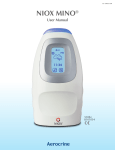

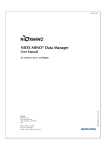
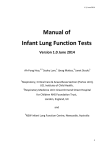
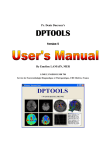

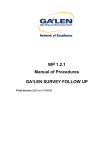
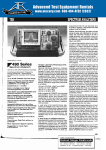
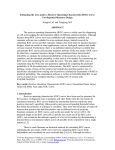




![[Product Monograph Template - Standard]](http://vs1.manualzilla.com/store/data/005786637_1-bbde87d0b5b85ef8c8ff6a7fd943fd08-150x150.png)
